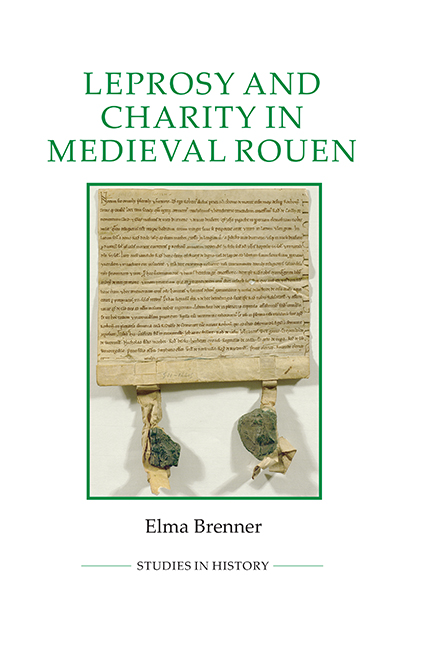Book contents
- Frontmatter
- Dedication
- Contents
- List of Illustrations
- Acknowledgements
- Abbreviations
- Introduction: Leprosy, Charity and Rouen
- 1 Rouen’s Principal Leper House: Mont-aux-Malades and Its Endowment
- 2 Charity and Community at Mont-aux-Malades
- 3 Rouen’s Other Leper Houses: Institutions, Gender and Status
- 4 Leprosy and the Medical World of Rouen
- 5 Leprosy and the Religious Culture of Rouen
- Conclusion
- Appendix 1 A Note on Sources
- Appendix 2 Charters and other Documents Relating to Leprosy in Rouen, c. 1100–c. 1500
- Bibliography
- Index
2 - Charity and Community at Mont-aux-Malades
Published online by Cambridge University Press: 07 May 2022
- Frontmatter
- Dedication
- Contents
- List of Illustrations
- Acknowledgements
- Abbreviations
- Introduction: Leprosy, Charity and Rouen
- 1 Rouen’s Principal Leper House: Mont-aux-Malades and Its Endowment
- 2 Charity and Community at Mont-aux-Malades
- 3 Rouen’s Other Leper Houses: Institutions, Gender and Status
- 4 Leprosy and the Medical World of Rouen
- 5 Leprosy and the Religious Culture of Rouen
- Conclusion
- Appendix 1 A Note on Sources
- Appendix 2 Charters and other Documents Relating to Leprosy in Rouen, c. 1100–c. 1500
- Bibliography
- Index
Summary
In the thirteenth century the fashion in Western Europe for Christian charity reached a peak, with the foundation and support of numerous hospitals, leprosaria, houses for poor women and other types of institution for the needy. Although Rouen underwent major changes in this century, following the annexation of Normandy to the French crown in 1204, Mont-aux-Malades remained a focus for high-status patronage, now receiving the support of the French royal family and household and, above all, that of Rouen's burgess elite. Initially, the involvement of members of the Anglo-Norman aristocracy also persisted. This chapter is built upon the rich documentary record for the leper house in this century, presenting a sample of material from the charters that record donations and other property transactions. Mont-aux- Malades evidently became a major property holder in Rouen at this time, by virtue of which the leper community was connected to mainstream society. The charter evidence and other sources, particularly the Register of Eudes Rigaud, also make it possible to reconstruct the community at Mont-aux- Malades, in the thirteenth century and beyond.
Aristocratic patronage for Mont-aux-Malades in the thirteenth century
In 1204 Philip Augustus annexed Normandy to the French royal domain, and English ties with Normandy were severed. Although continuity in ecclesiastical patronage was possible after 1204, as demonstrated by the gift by the dean and chapter of Rouen recorded in 1237, the close links of Mont-aux-Malades to the Anglo-Norman royal family and nobility were lost. Nonetheless, some nobles continued to support the leper house after 1204, evidencing the endurance of this group's links with Rouen in spite of the new political situation. Although in theory the Anglo-Norman barons were required to choose between their Norman and English lands in 1204, many endeavoured to retain their cross-channel estates. William I Marshal (1146–1219), for example, swiftly did homage to Philip Augustus for his wife Isabelle de Clare's lordship of Longueville in the Pays de Caux. These ties continued until the 1220s when, with obstacles such as port closures and the need to obtain travel permits between England and Normandy, the remaining cross-channel aristocratic interests declined.
- Type
- Chapter
- Information
- Leprosy and Charity in Medieval Rouen , pp. 38 - 57Publisher: Boydell & BrewerPrint publication year: 2015

